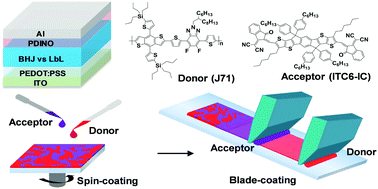当前位置:
X-MOL 学术
›
Energy Environ. Sci.
›
论文详情
Our official English website, www.x-mol.net, welcomes your feedback! (Note: you will need to create a separate account there.)
A universal layer-by-layer solution-processing approach for efficient non-fullerene organic solar cells†
Energy & Environmental Science ( IF 32.5 ) Pub Date : 2018-12-08 00:00:00 , DOI: 10.1039/c8ee02560f Rui Sun 1, 2, 3, 4 , Jing Guo 1, 2, 3, 4 , Chenkai Sun 5, 6, 7, 8, 9 , Tao Wang 1, 2, 3, 4 , Zhenghui Luo 2, 3, 4, 10, 11 , Zhuohan Zhang 4, 12, 13, 14, 15 , Xuechen Jiao 16, 17, 18, 19, 20 , Weihua Tang 4, 12, 13, 14, 15 , Chuluo Yang 2, 3, 4, 10, 11 , Yongfang Li 5, 6, 7, 8, 9 , Jie Min 1, 2, 3, 4
Energy & Environmental Science ( IF 32.5 ) Pub Date : 2018-12-08 00:00:00 , DOI: 10.1039/c8ee02560f Rui Sun 1, 2, 3, 4 , Jing Guo 1, 2, 3, 4 , Chenkai Sun 5, 6, 7, 8, 9 , Tao Wang 1, 2, 3, 4 , Zhenghui Luo 2, 3, 4, 10, 11 , Zhuohan Zhang 4, 12, 13, 14, 15 , Xuechen Jiao 16, 17, 18, 19, 20 , Weihua Tang 4, 12, 13, 14, 15 , Chuluo Yang 2, 3, 4, 10, 11 , Yongfang Li 5, 6, 7, 8, 9 , Jie Min 1, 2, 3, 4
Affiliation

|
Layer-by-layer (LbL) solution processing is a cost-effective technology for the large-scale fabrication of organic solar cells (OSCs). In this work, LbL OSCs were fabricated using PTQ10/J71 as donors and ITC6-IC/IDIC/MeIC/ITCPTC/ITIC as non-fullerene acceptors (NFAs) without using orthogonal solvents and appropriate co-solvents. Compared with traditional bulk heterojunction (BHJ) OSCs, the corresponding solution-processed LbL devices exhibited higher or comparable power conversion efficiencies (PCEs), which had the advantages of reduced energy loss, stronger absorption spectra, better vertical phase separation, partially increased charge transport property and charge collection efficiency. Furthermore, taking the J71/ITC6-IC and PTQ10/IDIC LbL systems as examples, we fabricated large-area LbL OSCs using the doctor-blading process, which is closer to the roll-to-roll (R2R) technology. Importantly, both OSCs based on J71/ITC6-IC and PTQ10/IDIC LbL with an active area of 1.00 cm2 demonstrated encouraging PCEs of over 10%, which is the record efficiency for large-area LbL OSCs reported in the literature to date. Our work indicates that the solution-processed LbL approach not only presents good generality and high device performance, but also is a superior alternative to the BHJ method for the initial evaluation of photovoltaic materials and the industrial production of R2R OSCs.
中文翻译:

高效非富勒烯有机太阳能电池的通用逐层解决方案处理方法†
逐层(LbL)解决方案处理是用于大规模制造有机太阳能电池(OSC)的一种经济高效的技术。在这项工作中,使用PTQ10 / J71作为供体,使用ITC6-IC / IDIC / MeIC / ITCPTC / ITIC作为非富勒烯受体(NFA)来制备LbL OSC,而无需使用正交溶剂和适当的助溶剂。与传统的体异质结(BHJ)OSC相比,相应的溶液处理的LbL器件显示出更高或相当的功率转换效率(PCE),具有以下优点:减少了能量损失,更强的吸收光谱,更好的垂直相分离,部分增加了电荷传输物业和收费效率。此外,以J71 / ITC6-IC和PTQ10 / IDIC LbL系统为例,我们使用刮墨刀工艺制造了大面积的LbL OSC,更接近卷对卷(R2R)技术。重要的是,两种基于J71 / ITC6-IC和PTQ10 / IDIC LbL的OSC的有效面积均为1.00 cm2显示出令人鼓舞的PCE超过10%,这是迄今为止文献中报道的大面积LbL OSC的创纪录效率。我们的工作表明,溶液处理的LbL方法不仅具有良好的通用性和较高的器件性能,而且是BHJ方法的替代品,可用于光伏材料的初始评估和R2R OSC的工业生产。
更新日期:2018-12-08
中文翻译:

高效非富勒烯有机太阳能电池的通用逐层解决方案处理方法†
逐层(LbL)解决方案处理是用于大规模制造有机太阳能电池(OSC)的一种经济高效的技术。在这项工作中,使用PTQ10 / J71作为供体,使用ITC6-IC / IDIC / MeIC / ITCPTC / ITIC作为非富勒烯受体(NFA)来制备LbL OSC,而无需使用正交溶剂和适当的助溶剂。与传统的体异质结(BHJ)OSC相比,相应的溶液处理的LbL器件显示出更高或相当的功率转换效率(PCE),具有以下优点:减少了能量损失,更强的吸收光谱,更好的垂直相分离,部分增加了电荷传输物业和收费效率。此外,以J71 / ITC6-IC和PTQ10 / IDIC LbL系统为例,我们使用刮墨刀工艺制造了大面积的LbL OSC,更接近卷对卷(R2R)技术。重要的是,两种基于J71 / ITC6-IC和PTQ10 / IDIC LbL的OSC的有效面积均为1.00 cm2显示出令人鼓舞的PCE超过10%,这是迄今为止文献中报道的大面积LbL OSC的创纪录效率。我们的工作表明,溶液处理的LbL方法不仅具有良好的通用性和较高的器件性能,而且是BHJ方法的替代品,可用于光伏材料的初始评估和R2R OSC的工业生产。


























 京公网安备 11010802027423号
京公网安备 11010802027423号